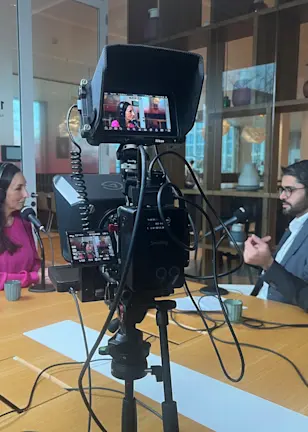Now the EU's Sustainable Finance Disclosure Regulation (SFDR) has swept into our lives and become mainstream since its initial publication in 2019. This EU regulation asks us to choose whether a company contributes to an environmental or to a social objective. We feel that this could lead confusion that becomes greater than the intended clarification. It gives rise to our SI dilemma: choose social or environmental?
Social and environmental goals are intertwined
Sustainability issues are ingrained into contours for mainstream investing today and it is clear that social and environmental matters are intertwined. This can be seen in the widely accepted framework that targets social and environmental issues under SDGs.
Frameworks that had previously solely focused on the environment have developed to also include social issues, and this appears not just as a climate transition, but in the development of the concept of a Just Transition.
The Earth Commission Global Commons Alliance, for example, has expanded on the important planetary boundaries concepts to construct a set of new Earth System Boundaries (ESBs). In addition to environmental limits, these ESBs include social metrics and social safety boundaries to minimize the harm caused by boundary breaches on human health and well-being, as well as addressing issues of fairness and justice.
Within the SFDR regulation, one of the many investment strategies requirements include setting up minimum commitments for sustainable investments that can contribute to environmental and/or social objectives.1 The European Commission advised that there must be no double counting of such sustainable investments, and where an investment contributes to both objectives, the investor must decide to which objective – environmental or social – the investment should be better aligned with.2
Robeco’s approach
Robeco operationalized such an ask through our own SDG framework, which we believe accurately assesses whether a company contributes positively to sustainable development and can therefore be categorized as a sustainable investment.
As is well known, the SDGs provide a holistic base including targets on a number of sustainability issues ranging from social issues (hunger, education, health care) and environmental concerns (biodiversity, climate change, marine, coastal, and water-related ecosystems). We can look through and segregate the 17 SDGs to identify social or environmental objectives.
For identifying companies that promote an environmental objective, SDG 12 (Responsible consumption and production), SDG 13 (Climate action), SDG 14 (Life below water) and SDG 15 (Life on land) we considered such factors relevant. Similarly, the SDGs identified as contributing towards social objectives were SDGs 1 to 11 and more specifically SDG 16 (Peace, justice and strong institutions).
These ‘social SDGs’ are mainly related to issues targeting improvements to society and community welfare such as the goals eradicating hunger, improving education, infrastructure and health care. Given the higher number of social objectives, it is likely that we would see a higher number of companies contributing to a social objective. Robeco internal data as of July 2023 depicts such results in the chart below.

Data for SI as of July 2023 – Environmental or social3 in the corporate universe
Joined at the hip
While the above descriptors serve as a logical method to categorize companies across sectors and investment strategies, a closer look at the SDGs flags the complexities involved. It is commonly acknowledged that the 17 goals are interconnected, and actions taken to improve one objective do influence another SDG.4
Further, several SDGs have both environmental and social sub-targets. For example, SDG 7 (Affordable and clean energy) aims to provide access to energy for all (7.1 – a social goal), but also increase renewable energy generation and increase energy efficiency (7.2 and 7.3 – environmental goals). Similarly, SDG 6 (Clean water and sanitation) aims to improve human health (a social goal) as well as reduce water pollution (an environmental goal). Thus, at the heart of this conundrum, lies the question whether a clear choice on environmental or social objective can be made.
Invariably, such categorization also leads to assessment outcomes where companies could well be equally linked to both a social and environmental SDG. For instance, companies supplying insulation materials contribute to energy efficiency which is connected to an environmental goal (SDG 7) and a social goal (SDG 9: Industry, innovation and infrastructure).
Another example is companies that supply salmon to consumers and thereby provide healthy food contributing to SDG 2 (Zero hunger), which is a social objective. Under Robeco’s SDG Framework, such companies will only be positively scored on SDG 14 if they adopt environmentally friendly practices that can be verified with high certification levels (the ASC for fisheries and/or MSC for wild catches). If so, they can be classified as serving an environmental objective, even with a product that also serves a social intent.
We can find many other examples of companies for whom the social and environmental contributions they make through their products or services are intertwined. At Robeco, the criteria we use is to categorize them according to the highest impact that we think their products and services make, whether this be socially or environmentally.
SI Debate
Clarification or confusion?
But it’s not easy. Going beyond the company level and assessing commitments toward environmental or social goals from a top-down objective at the investment product level is formidable. It is no surprise then that an investment strategy can indicate an environmental objective through its portfolio names, but can also include many holdings which contribute to a social objective.
For example, a renewable energy investment strategy, which has a clear environmental goal, can show a higher commitment to making sustainable investments by using a social objective instead of stating its more obvious contribution to environmental objectives. We believe this creates more confusion than clarification.
Ultimately, for investors and clients, the precontractual commitments toward environmental or social goals should not be understood as representing the strategy’s overarching objective. These commitments are based in our view on the sustainability goal that a company aspires to, as explained above, and such views can differ. Investors should be aware of this dichotomy and therefore they need to keep a keen eye on what the strategy actually invests in.
We do understand that the European Commission does not want us to double count contributions, but at Robeco we view sustainability holistically, and believe in the dictum that there is no advancing the environmental goals without also having good social and governance practices. We feel that the whole is bigger than the sum of its parts. And who wants to argue with Aristotle?
Bhavya Sharma contributed to this column.
Footnotes
1 2022-12-02 | CSSF FAQ Sustainable Finance Disclosure Regulation (SFDR), p12.
2 2022-11-17 | Questions and answers (Q&A) on the SFDR Delegated Regulation, p32.
3 Qlik base in July 2023 data. Number of sustainable investments: 8411; Number of environmentally sustainable investments: 1954; Number of social sustainable investments: 6431
4 Pakkan, S., Sudhakar, C., Tripathi, S. et al. A correlation study of sustainable development goal (SDG) interactions. Qual Quant 57, 1937–1956 (2023).
Important information
This information is for informational purposes only and should not be construed as an offer to sell or an invitation to buy any securities or products, nor as investment advice or recommendation. The contents of this document have not been reviewed by the Monetary Authority of Singapore (“MAS”). Robeco Singapore Private Limited holds a capital markets services license for fund management issued by the MAS and is subject to certain clientele restrictions under such license. An investment will involve a high degree of risk, and you should consider carefully whether an investment is suitable for you.



















